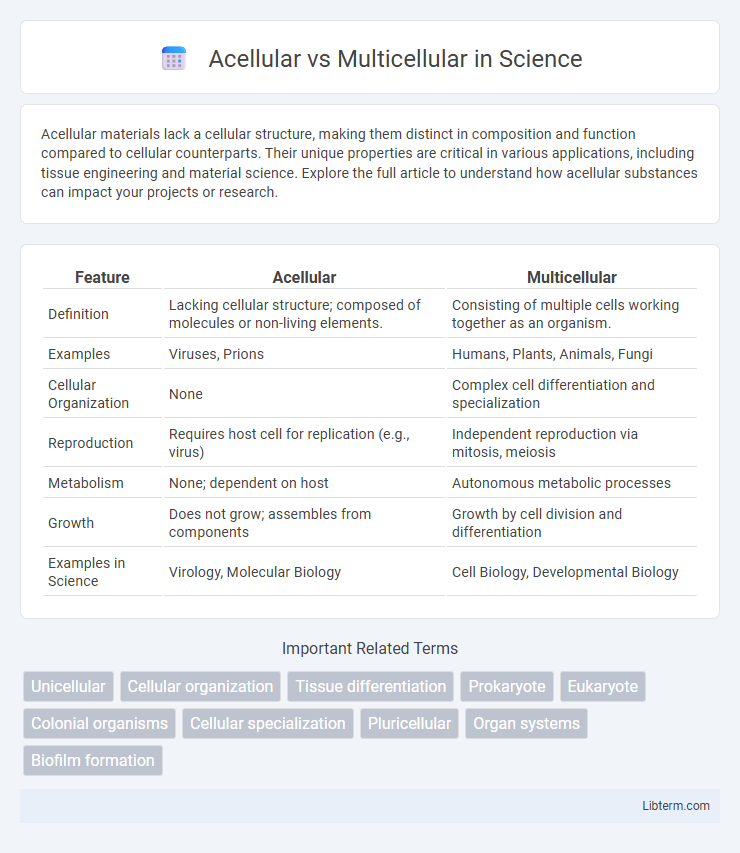Acellular materials lack a cellular structure, making them distinct in composition and function compared to cellular counterparts. Their unique properties are critical in various applications, including tissue engineering and material science. Explore the full article to understand how acellular substances can impact your projects or research.
Table of Comparison
| Feature | Acellular | Multicellular |
|---|---|---|
| Definition | Lacking cellular structure; composed of molecules or non-living elements. | Consisting of multiple cells working together as an organism. |
| Examples | Viruses, Prions | Humans, Plants, Animals, Fungi |
| Cellular Organization | None | Complex cell differentiation and specialization |
| Reproduction | Requires host cell for replication (e.g., virus) | Independent reproduction via mitosis, meiosis |
| Metabolism | None; dependent on host | Autonomous metabolic processes |
| Growth | Does not grow; assembles from components | Growth by cell division and differentiation |
| Examples in Science | Virology, Molecular Biology | Cell Biology, Developmental Biology |
Introduction to Acellular and Multicellular Life
Acellular life refers to organisms or entities that lack cellular structures, such as viruses and prions, which rely on host cells for replication and metabolic processes. Multicellular life consists of organisms composed of multiple specialized cells that perform distinct functions, enabling complex biological systems and higher-order organization. Understanding the fundamental differences between acellular and multicellular life highlights variations in biological complexity, reproduction, and evolutionary adaptation.
Defining Acellular Organisms
Acellular organisms consist of entities that lack a cellular structure, such as viruses, which rely on host cells for replication and metabolic functions. Unlike multicellular organisms composed of multiple specialized cells working synergistically, acellular entities do not have membranes or organelles. Defining acellular organisms highlights their inability to carry out independent metabolic processes, distinguishing them fundamentally from multicellular life forms.
Characteristics of Multicellular Organisms
Multicellular organisms consist of multiple specialized cells that perform distinct functions, enabling complex structures and systems such as tissues, organs, and organ systems. These organisms exhibit cellular differentiation and communication through signaling pathways, allowing coordinated growth and development. Multicellularity supports increased size, longevity, and adaptability compared to acellular or unicellular forms.
Structural Differences: Acellular vs Multicellular
Acellular structures lack cellular organization, consisting mainly of non-living components such as proteins and polysaccharides, while multicellular organisms are composed of multiple cells organized into tissues and organs. Acellular entities, like viruses, do not have cellular membranes, cytoplasm, or nuclei, unlike multicellular organisms which exhibit complex cellular compartments and specialization. The fundamental structural difference lies in the presence of individual cells with distinct functions in multicellular life forms versus the absence of cells in acellular entities.
Modes of Reproduction
Acellular organisms reproduce primarily through binary fission, budding, or fragmentation, where a single entity divides or forms new individuals without the involvement of cellular differentiation. Multicellular organisms exhibit various modes of reproduction including sexual reproduction, which involves gamete fusion and genetic recombination, and asexual reproduction such as vegetative propagation or parthenogenesis. Cellular differentiation and tissue organization play critical roles in multicellular reproduction, enabling the development of complex offspring from a single fertilized cell.
Evolutionary Significance
Acellular organisms, such as viruses, represent primitive biological entities that rely on host cells for replication, highlighting the early evolutionary transition toward cellular life forms. Multicellular organisms display increased complexity and specialization, enabling enhanced survival through division of labor among differentiated cells, which marks a pivotal evolutionary advancement. The shift from acellular to multicellular life demonstrates significant adaptive innovation promoting biodiversity and ecosystem complexity.
Examples of Acellular Entities
Acellular entities include viruses, prions, and viroids, which lack cellular structures and metabolic processes, distinguishing them from multicellular organisms like plants and animals composed of numerous cells with specialized functions. Viruses consist of genetic material encased in a protein coat and rely entirely on host cells for replication, while prions are infectious proteins causing neurodegenerative diseases. Viroids are small, circular RNA molecules that infect plants, representing the simplest form of acellular life.
Examples of Multicellular Life Forms
Examples of multicellular life forms include animals, plants, and fungi, all composed of multiple specialized cells working together to perform complex functions. Humans, fish, and trees exemplify animals and plants with intricate cellular differentiation supporting growth, reproduction, and metabolism. In contrast, acellular entities like viruses lack cellular structure and depend on host cells for replication.
Biological Roles and Functions
Acellular organisms, such as viruses, lack cellular structure and rely on host cells for replication, playing critical roles in gene transfer, evolution, and disease dynamics. Multicellular organisms consist of specialized cells organized into tissues and organs, enabling complex biological functions like metabolism, growth, and homeostasis. The division of labor in multicellular life forms enhances survival, adaptation, and environmental interaction compared to acellular entities.
Acellular vs Multicellular: Key Takeaways
Acellular organisms lack cellular structures and are typically comprised of genetic material encased in protein, as seen in viruses, whereas multicellular organisms consist of multiple specialized cells forming tissues and organs, like plants and animals. Acellular entities cannot carry out metabolic processes independently, relying on host cells for replication, contrasting with multicellular organisms that maintain homeostasis through coordinated cellular functions. Understanding the distinction between acellular and multicellular life forms is crucial in fields such as microbiology and medical research for disease treatment and biotechnology advancements.
Acellular Infographic

 libterm.com
libterm.com